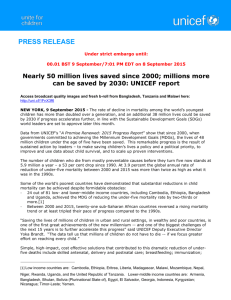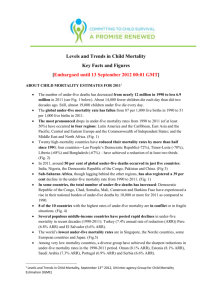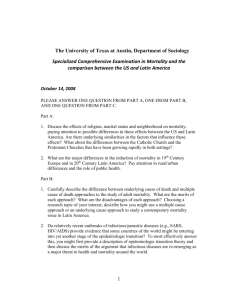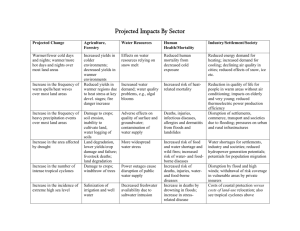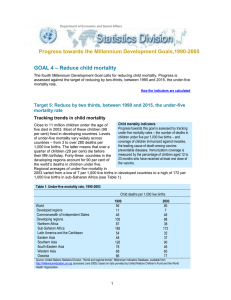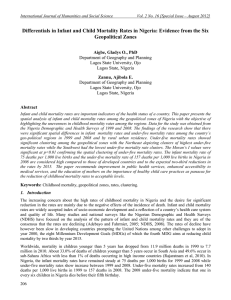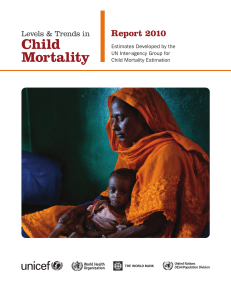FACT SHEET ON CHILD SURVIVAL
advertisement
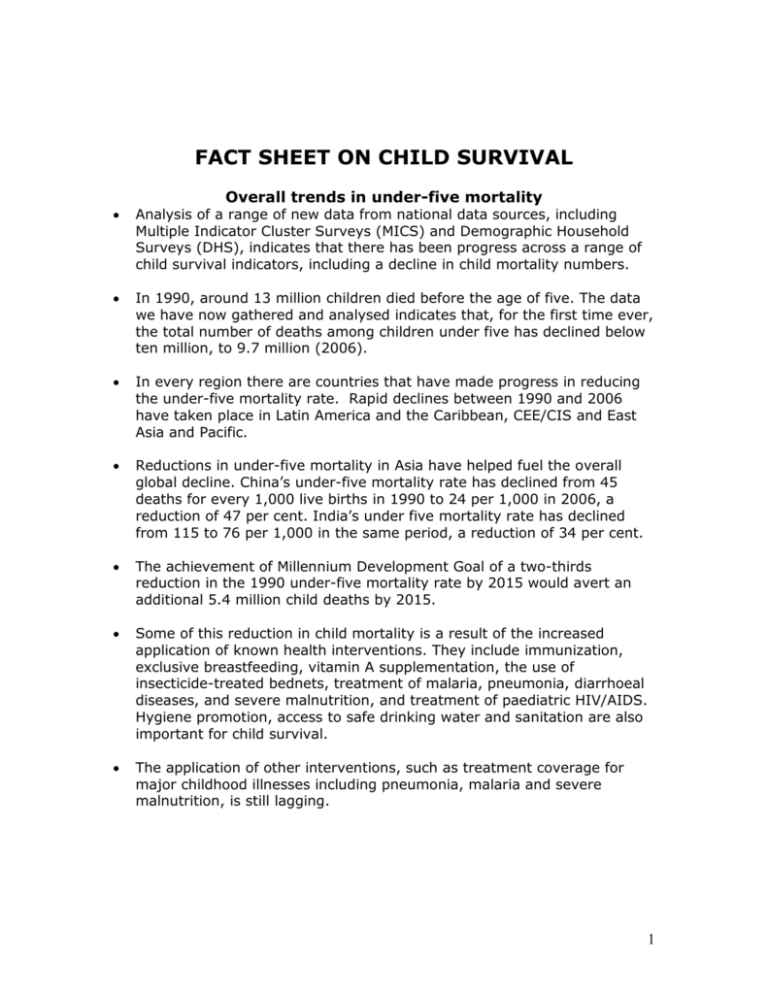
FACT SHEET ON CHILD SURVIVAL Overall trends in under-five mortality Analysis of a range of new data from national data sources, including Multiple Indicator Cluster Surveys (MICS) and Demographic Household Surveys (DHS), indicates that there has been progress across a range of child survival indicators, including a decline in child mortality numbers. In 1990, around 13 million children died before the age of five. The data we have now gathered and analysed indicates that, for the first time ever, the total number of deaths among children under five has declined below ten million, to 9.7 million (2006). In every region there are countries that have made progress in reducing the under-five mortality rate. Rapid declines between 1990 and 2006 have taken place in Latin America and the Caribbean, CEE/CIS and East Asia and Pacific. Reductions in under-five mortality in Asia have helped fuel the overall global decline. China’s under-five mortality rate has declined from 45 deaths for every 1,000 live births in 1990 to 24 per 1,000 in 2006, a reduction of 47 per cent. India’s under five mortality rate has declined from 115 to 76 per 1,000 in the same period, a reduction of 34 per cent. The achievement of Millennium Development Goal of a two-thirds reduction in the 1990 under-five mortality rate by 2015 would avert an additional 5.4 million child deaths by 2015. Some of this reduction in child mortality is a result of the increased application of known health interventions. They include immunization, exclusive breastfeeding, vitamin A supplementation, the use of insecticide-treated bednets, treatment of malaria, pneumonia, diarrhoeal diseases, and severe malnutrition, and treatment of paediatric HIV/AIDS. Hygiene promotion, access to safe drinking water and sanitation are also important for child survival. The application of other interventions, such as treatment coverage for major childhood illnesses including pneumonia, malaria and severe malnutrition, is still lagging. 1 Progress in sub-Saharan Africa While under-five mortality rates are still high in Sub-Saharan Africa, there has been encouraging progress in the application of a number of health interventions in this region. Significant progress has been made in exclusive breastfeeding in 16 Sub-Saharan African countries since 1995, with six countries showing increases of 20 per cent or more. Vitamin A supplementation has increased to 73 per cent and there has been a 75 per cent reduction in measles mortality. All Sub-Saharan African countries for which trend data is available have shown real progress since 2000 in the coverage of insecticide-treated nets to protect children against malaria. ORT coverage for diarrhoeal diseases has also improved over the last decade. There has been significant progress in child mortality in some SubSaharan African countries. Under-five mortality has declined 29 per cent between 2000 and 2004 in Malawi. In Ethiopia, Mozambique, Namibia, Niger, Rwanda and Tanzania child mortality rates have declined by more than 20 per cent. Despite this progress, reaching the target of a two-thirds reduction in child mortality across Sub-Saharan Africa will require a 10-fold increase in the annual rate of progress between today and 2015. Importance of country support for data collection and analysis The assessment of progress in coverage of key child survival interventions is based on the ongoing and extensive work by UNICEF and its partners to monitor the global situation of children and women. Before the mid-1990s, there were critical gaps in the data available to monitor the situation of children and women. For example, only 38 developing countries had data on whether malnutrition rates among their children were rising or falling – a basic indicator of child health and wellbeing. In 1995 UNICEF developed a household survey methodology - the Multiple Indicator Cluster Surveys (MICS) – to support these countries to fill these important data gaps. Since 1995, nearly 200 MICS surveys have been conducted in approximately 100 countries. The current round of MICS surveys was implemented in over 50 countries during 2005-06. These surveys, along with the USAID-supported Demographic and Health Surveys (DHS), are the largest single source of information about progress towards the Millennium Development Goals and form the basis of the assessment of progress in child survival intervention coverage. 2 Under 5 mortality rate SUMMARY INDICATORS Sub-Saharan Africa Eastern and Southern Africa West and Central Africa Middle East and North Africa South Asia East Asia and Pacific Latin America and Caribbean CEE/CIS Industrialized countries Developing countries Least developed countries World 1960 1990 2006 % change 1990-2006 277 252 300 249 238 121 154 91 39 219 276 184 187 165 208 78 123 55 55 53 10 103 180 93 160 131 186 46 83 29 27 27 6 79 142 72 14 21 11 41 33 47 51 49 40 23 21 23 Total for the 60 countries that account 234 for 84% 112 of all under-five 88 deaths 21 Under 5 deaths [ in millions ] Sub-Saharan Africa Eastern and Southern Africa West and Central Africa Middle East and North Africa South Asia East Asia and Pacific Latin America and Caribbean CEE/CIS Industrialized countries Developing countries Least developed countries World 1990 4.1 1.8 2.4 0.7 4.7 2 0.6 0.4 0.1 12.5 4 12.7 2006 4.8 1.9 2.9 0.4 3.1 0.9 0.3 0.2 0.1 9.6 4.1 9.7 % change 1990-2006 -17 -6 -21 43 34 55 50 50 0 23 -2 24 Total for the 60 countries that account for 84% 11.4 of all under-five 9.2 deaths 19 3


